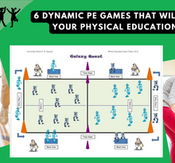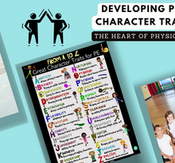Physical education plays a vital role in the holistic development of students. It offers numerous benefits, including promoting physical fitness, enhancing motor skills, and instilling a lifelong appreciation for physical activity. However, the true potential of physical education is often overshadowed by the perceived difficulty of assessing student learning and achievement in this context. The aim of this article is to demystify the concept of assessment in physical education and provide PE teachers with comprehensive strategies to ensure student progress and enhance teaching practices.

As the field of education continues to evolve, so too must the methodologies applied in the classroom, including those in the gymnasium or on the sports field. Traditionally, physical education assessment was focused on the more easily quantifiable aspects of fitness levels and specific skills. But a more comprehensive approach incorporates diverse assessment methods that not only evaluate physical abilities but also account for personal improvement, student understanding, and knowledge of physical activities.
Understanding the Role of Assessment in Physical Education
Assessment in PE is crucial for gauging student progress, refining curriculum, and enhancing teaching strategies. It provides a reliable way to measure the development of specific skills, including motor abilities, knowledge, and understanding of various physical activities, and the personal and social growth that accompanies participation in physical education class. Consequently, physical education assessments offer invaluable data to teachers, students, and parents about student achievement, forming the basis for setting new goals, providing feedback, and making inferences about future instruction.

The role of assessment is not limited to the measurement of the students' physical abilities. It extends to the evaluation of cognitive growth, understanding of the rules and strategies of specific sports, and development of teamwork, leadership, and ethical behavior. Moreover, assessment in physical education plays a critical role in promoting students' self-evaluation skills, encouraging them to take responsibility for their learning.
Utilizing Rubrics in Physical Education Assessment
Rubrics serve as essential tools for PE teachers

when conducting assessments. These established scoring criteria help to evaluate a student's performance in an organized, consistent, and objective manner. They offer clarity about what is expected of students, providing them with specific performance expectations and a clearer understanding of what constitutes success.
Well-constructed rubrics detail varying levels of proficiency for each learning objective, allowing teachers to pinpoint where a student is excelling and where improvement is needed. Additionally, rubrics facilitate constructive feedback, enabling students to understand their strengths and weaknesses better. They also promote consistency in evaluation and make the
assessment process transparent, promoting student understanding and fairness.
Formative Assessment in Physical Education
Formative assessment, also known as assessment for learning, is an ongoing process that occurs during instruction. It allows teachers to monitor student learning, provide feedback, and adjust instructional strategies to enhance student achievement. In the context of physical education, formative assessments can include peer assessment, self-assessment, exit assessment slips, and exit checks.
Peer assessment: Peer assessment encourages students to constructively critique each other's performance. It promotes the development of communication skills and a better understanding of the learning objectives. This form of assessment can be particularly effective in team sports and group physical activities, where students can give and receive feedback about specific skills or teamwork strategies.
Self-assessment: Self-assessment promotes self-reflection and personal improvement. Students assess their own performance, identify their strengths and weaknesses, and set goals for improvement. This formative assessment method fosters a sense of responsibility and accountability for one's own learning and progress.
Exit assessment slips: These are quick assessments at the end of a lesson where students write what they learned, questions they might have, or difficulties they experienced. They help teachers understand the effectiveness of the lesson and provide insight into students' understanding.
Exit checks: These quick checks at the end of class assess student understanding of the day's lesson. Students can point to or touch a visual on the way out of class to self-assess their performance for the day.
Looking to enhance your physical education program with targeted professional development? Visit PEWorkshops.com to explore onsite and virtual workshops from Mark Manross Consulting, customized to meet the unique needs of PE teachers.
Summative Assessment in Physical Education
While formative assessments focus on ongoing feedback during the learning process, summative assessments occur at the end of a unit, semester, or school year. They provide an overall measure of student learning and achievement. Examples of summative assessments in physical education include fitness tests, skill performance assessments, written assessments, or team sport participation.
Summative assessments are useful for making inferences about student achievement over time and their readiness for the next level of physical education. They also help physical education teachers report student progress to parents and school administrators.
Authentic Assessment in Physical Education

Authentic assessment in physical education refers to evaluating students in situations that replicate real-world activities rather than contrived testing scenarios. For example, rather than simply testing a student's ability to kick a soccer ball, an authentic assessment would involve evaluating the student's performance during an actual game, taking into account their skill execution, decision-making, and teamwork.
Authentic assessment offers a comprehensive view of a student's abilities. It values the learning process, rewards meaningful learning, and mirrors the kind of work students are likely to encounter outside of the school environment.
Utilizing Assessment Data in Physical Education
Assessment data from a PE class serves as valuable resource for a physical education teacher. The data offers insights into students' physical abilities, understanding of PE concepts, and progress in various skills and objectives. By evaluating this data, teachers can identify trends, spot challenges, and tailor their instruction to better meet students' needs.
For instance, if PE assessment data show that many students struggle with a specific skill, the teacher might revisit that skill in subsequent lessons, provide additional practice opportunities, or adapt their teaching strategies to improve student understanding and performance. Furthermore, assessment data can also help professionals teaching physical education communicate more effectively with parents about their child's progress and learning needs in PE.
The Four Essential Components of Physical Education Assessment
There are four essential components to effective physical education assessment:

1 - Ongoing evaluation: Assessing student performance and progress should be a regular part of the physical education class. Consistent evaluation provides timely feedback to students and informs instruction.
2 - Diverse assessment methods: Utilizing a mix of formative, summative, and authentic assessments ensures a comprehensive evaluation of student learning.

3 - Student involvement: Engaging students in the assessment process through peer and self-assessment encourages active participation in their learning journey.
4 - Data-informed decision-making: Utilizing assessment data to inform teaching strategies and learning objectives ensures that physical education is responsive and tailored to students' needs.
Final Thoughts
Physical education plays a critical role in student development, promoting physical fitness, motor skills, and a love for physical activity. However, to fully realize its benefits, a comprehensive and effective assessment strategy is necessary. Through a combination of rubrics, formative, summative, and authentic assessments, physical educators can track student progress, adapt their teaching strategies, and enhance student learning.

Assessment in physical education is not just about evaluating student performance but is an essential tool for improving teaching practices and promoting student achievement. It allows teachers to create a learning environment that meets students' unique needs, encourages personal growth, and prepares them for a lifetime of physical activity.
As we move forward, we must embrace a broader vision of assessment in physical education—one that views each student holistically, values their personal improvement, and uses assessment data to continually enhance the quality of physical education.
How do you assess your students (formative and summative) during PE? Let us know in the comments below?
FREE Assessment Rubric Visual for Your Learning Space!
Do you need a practical rubric visual to help you highlight and showcase how you assess your PE students for a skill, movement or concept? If so, Cap'n Pete's Power PE has you covered! This FREE colorful Physical Education visual (poster) displays an Olympic-themed, 4-point grading rubric that can be utilized by teachers during student assessment in physical education. It can also be informative for students during PE skill self-assessment and by their classmates through peer-assessment.

Fill out the form below to download the physical education rubric visual that you can use to reference when assessing your students. PE Poster: 4 Point Rubric- Olympic Themed (Go for the Gold) - in 5 color schemes displays the 3 Olympic medals as motivation to improve PE assessment scores and provides a descriptor statement and graphical icons to help students easily relate to each score point.
This freebie set will be sure to enhance your PE program for years!
Need Some Easy to Implement Resources to Help Assess Physed Skills & Movements?
Download 24 practical assessment sets for several skill and movement actions for physical education students from 2nd to 8th Grade! The PE Assessment Series: Super Bundle: 24 Skill and Movement Assessment Sets is a comprehensive bundle of teacher, peer and self-assessment visuals teachers and students can easily use for formative and summative assessment in a PE setting.
You can download the bundle (or individual resources) from either of the following platforms: Cap'n Pete's Power PE Website or Teachers Pay Teachers- Cap'n Pete's TPT Store
Each assessment format can be used by a physical education teacher for formative or summative assessment purposes. The different sheets share the same visuals, element descriptors and basic rubric system. The teacher versions (Pre/Post-test and Single test variation) allow for scoring to be conducted by the teacher while the peer and self-reflection versions provide an area for student reflection.
What Skills and Movements are included in the PE Assessment Series Super Bundle?
8. Forehand Strike ️
10. Kicking a Ball
11. Punting a Ball
13. Forward Roll
14. Jumping Rope
15. Overhand Volley
16. Pushup
18. Underhand Volley
19. Galloping
20. Leaping
21. One Foot Hopping
22. Skipping
23. Slide Stepping
24. Two Foot Jumping

























